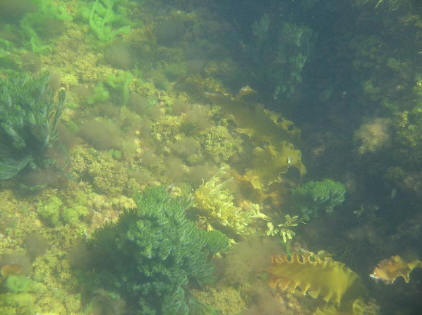Seaweed Photo Galleries
Green seaweeds
'Fuzzy' seaweeds
Rockweeds
Kelp Irish moss
Barnacles
"White Rocks"
2005 Seaweed Update

 Today's
changing
trends in seaweeds undoubtedly hold important clues as to the exact nature of
the 'trouble' affecting marine life in general. The most usual interpretation of
seaweed changes appears to be to attribute changes to nutrient overload, or "eutrophication,"
of coastal waters. (Schramm and Nienhuis, 1996) And sometimes changes are
attributed to global warming. (Barry et al. 1995) But a close look, considering
all species together, seems to give clearly conflicting signals...the presence
in northern temperate zones of many new short-lived
green seaweeds and fuzzy, filamentous types,
is widely thought to have been stimulated by an INCREASING availability of
dissolved nutrients in seawater. But, often growing on the same rock are
examples of the previously dominant thicker, longer-lived species (kelp,
rockweed, Irish moss)
displaying changes that appear to have been induced by a DECREASING availability
of dissolved nutrients. Which is it? In the photo at right of subtidal seaweeds
at Shad Bay, N.S., tan and green 'fuzzy' growths are prevalent (due to high
nutrients?) and Irish moss, rockweed and kelp all show relatively low pigmentation
(due to low nutrients?). Also the green perennial Codium fragile shows
prominent colorless hair development, a characteristic of this plant when grown
under conditions of low nutrient availability. (Lobban and Harrison, 1994) In
Atlantic Canada, this area contains far fewer fish
than it did years ago, and populations of
barnacles and mussels are in decline. All of these facts need to be
considered together, if we hope to solve the puzzle. Correct conclusions are
unlikely to be drawn based on the appearance of one seaweed species, or the
abundance of one fish stock. I've grouped the seaweed photos into six
galleries...but a 'single species approach' is inappropriate here, all must be
considered together. A gallery of barnacles is included (although they are
obviously not algae) because of their proximity, and the necessity of looking at
plants and animals together when assessing the health of ecosystems. Links to
galleries: Today's
changing
trends in seaweeds undoubtedly hold important clues as to the exact nature of
the 'trouble' affecting marine life in general. The most usual interpretation of
seaweed changes appears to be to attribute changes to nutrient overload, or "eutrophication,"
of coastal waters. (Schramm and Nienhuis, 1996) And sometimes changes are
attributed to global warming. (Barry et al. 1995) But a close look, considering
all species together, seems to give clearly conflicting signals...the presence
in northern temperate zones of many new short-lived
green seaweeds and fuzzy, filamentous types,
is widely thought to have been stimulated by an INCREASING availability of
dissolved nutrients in seawater. But, often growing on the same rock are
examples of the previously dominant thicker, longer-lived species (kelp,
rockweed, Irish moss)
displaying changes that appear to have been induced by a DECREASING availability
of dissolved nutrients. Which is it? In the photo at right of subtidal seaweeds
at Shad Bay, N.S., tan and green 'fuzzy' growths are prevalent (due to high
nutrients?) and Irish moss, rockweed and kelp all show relatively low pigmentation
(due to low nutrients?). Also the green perennial Codium fragile shows
prominent colorless hair development, a characteristic of this plant when grown
under conditions of low nutrient availability. (Lobban and Harrison, 1994) In
Atlantic Canada, this area contains far fewer fish
than it did years ago, and populations of
barnacles and mussels are in decline. All of these facts need to be
considered together, if we hope to solve the puzzle. Correct conclusions are
unlikely to be drawn based on the appearance of one seaweed species, or the
abundance of one fish stock. I've grouped the seaweed photos into six
galleries...but a 'single species approach' is inappropriate here, all must be
considered together. A gallery of barnacles is included (although they are
obviously not algae) because of their proximity, and the necessity of looking at
plants and animals together when assessing the health of ecosystems. Links to
galleries:
Green seaweeds
Rockweeds
Fuzzy seaweeds Kelp
Irish moss
Barnacles
2005 Seaweed Update
References:
Barry, J. P., C. H.
Baxter, R. D. Sagarin, and S. E. Gilman. 1995. Climate-related, long-term faunal
changes in a California rocky intertidal community. Science 267:672-675.
Lobban, Christopher
S. and Paul J. Harrison. 1994. Seaweed Ecology and Physiology. Cambridge
University Press.
Schramm, Winfrid and Pieter H. Nienhuis (eds). 1996. Marine Benthic Vegetation,
Recent Changes and the Effects of Eutrophication. Springer.
|
